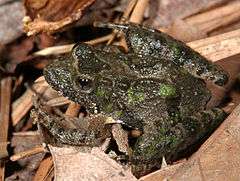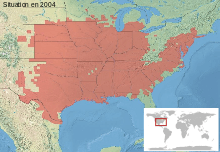Northern cricket frog
The northern cricket frog (Acris crepitans) is a species of small hylid frog native to the United States and northeastern Mexico. Despite being members of the tree frog family, they are not arboreal. It has two recognized subspecies.
| Northern cricket frog | |
|---|---|
 | |
| Scientific classification | |
| Kingdom: | Animalia |
| Phylum: | Chordata |
| Class: | Amphibia |
| Order: | Anura |
| Family: | Hylidae |
| Genus: | Acris |
| Species: | A. crepitans |
| Binomial name | |
| Acris crepitans Baird, 1854 | |
| Subspecies | |
|
Acris crepitans crepitans | |
 | |
Description
The northern cricket frog is one of North America's three smallest vertebrates, ranging from 19–38 mm (0.75–1.50 in) long. Its dorsal coloration varies widely, and includes greys, greens, and browns, often in irregular blotching patterns. One New York biologist has identified six distinct color morphs and four pattern morphs, and several intergrades between these.[2] Typically there is dark banding on the legs and a white bar from the eye to the base of the foreleg. The skin has a bumpy texture. It is very similar to the southern cricket frog, Acris gryllus, found in the US Southeastern Coastal Plain, but with some overlap along the Fall Line. The southern cricket frog has longer legs, with less webbing on the hind feet, and a more pointed snout; northern cricket frogs have been observed with snouts indistinguishable from those of the southern species.[3] The line on the back of its thigh is typically more sharply defined than that of the northern cricket frog.[4] Biologists have recorded northern cricket frogs in the northern fringes of their range with extremely sharp posterior leg stripes.
Behavior and diet
Northern cricket frogs are diurnal and generally active much of the year, except in midwinter in northern areas when the water is frozen. Their primary diet is small (13 to 38 mm (0.5 to 1.5 in) long) insects, including mosquitos. They are, in turn, preyed upon by a number of species, including birds, fish, and other frogs. To escape predators, they are capable of leaping up to 3 feet in a single jump and are excellent swimmers.
Reproduction
Breeding generally occurs from May through July. The males call from emergent vegetation with a high-pitched, short, pebble-like call which is repeated at an increasing rate. The sound suggests pebbles being clicked together, much like a cricket, hence the name. One egg is laid at a time, generally attached to a piece of vegetation. The 14 millimetres (0.55 in) tadpoles hatch in only a few days, and undergo metamorphosis in early fall. Maturity is usually reached in less than a year.
Habitat
Cricket frogs prefer the edges of slow-moving, permanent bodies of water. Large groups of them can often be found together along the muddy banks of shallow streams, especially during premigratory clustering. The northern cricket frog has been observed to hibernate upland, often at considerable distances from water.
Subspecies

- Eastern cricket frog, A. c. crepitans (Baird, 1854)
- Coastal cricket frog, A. c. paludicola (Burger, Smith and Smith, 1949)
Geographic distribution
- A. c. crepitans is found from New York, south to Florida, and west along the Gulf Coast states to Texas.
- A. c. paludicola occurs in southwestern Louisiana to East Texas.
Conservation status
Frogs such as A. crepitans are important as an indicator of wetland health and general environmental quality in the areas they inhabit.
References
- Hammerson, G.; Santos-Barrera, G. & Church, D. (2004). "Acris crepitans". IUCN Red List of Threatened Species. 2004: e.T55286A11272584. doi:10.2305/IUCN.UK.2004.RLTS.T55286A11272584.en.
- (Westerveld,1977).
- (Westerveld, 1998).
- (Conant et al. 1998, Martof et al. 1980).
External links
| Wikispecies has information related to Northern cricket frog |
| Wikimedia Commons has media related to Northern cricket frog. |
- Animal Diversity Web: Acris crepitans
- USGS: Northern Cricket Frog
- Frogs & Toads of Georgia: Acris crepitans crepitans
- Conant et al. (1998). A Field Guide to Reptiles and Amphibians of Eastern and Central North America. Boston: Houghton Mifflin. ISBN 0-395-90452-8.
- Martof et al. (1980). Amphibians and Reptiles of the Carolinas and Virginia. Chapel Hill: University of North Carolina Press. ISBN 0-8078-4252-4.
